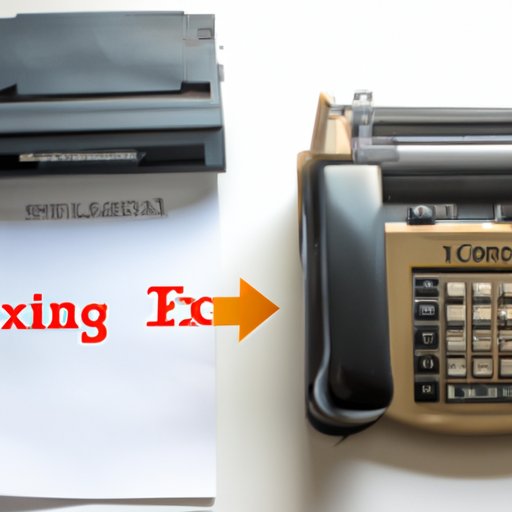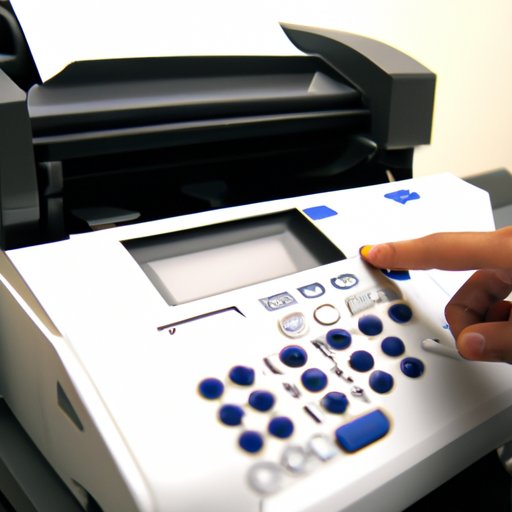Introduction
Faxing is one of the oldest forms of communication still in use today. It is defined as the transmission of documents over telephone lines from one machine to another, allowing users to quickly and securely send written information around the world. Despite its age, faxing is still an important tool in many businesses, especially when it comes to sending sensitive documents. This article will take an in-depth look at how faxing works, from the basics of connecting and setting up a fax machine to the technology behind the process and the evolution of faxing over time.
A Step-by-Step Guide to Faxing
Faxing is relatively straightforward and easy to understand. Here is a step-by-step guide to the process:
Connecting and Setting Up a Fax Machine
The first step in faxing is connecting the fax machine to your phone line. Most fax machines have a dedicated port for this purpose, though some require an adapter. Once the connection has been made, you can begin setting up the machine. This usually involves selecting a language, setting the date and time, and entering your contact details. Once the machine is set up, you are ready to start sending and receiving faxes.
Sending a Fax
To send a fax, you will need to place the document into the fax machine’s scanner or feeder tray. You can then enter the recipient’s phone number and press “Send”. The fax machine will then dial the number and transmit the document over the phone line. The recipient’s machine will then receive the document and print it out.
Receiving a Fax
When someone sends you a fax, the machine will automatically detect the incoming call and begin printing out the document. Depending on the type of machine you have, you may also be able to view the document on the LCD screen before deciding whether or not to print it out.
How Does a Fax Machine Work?
Now that we have covered the basics of how to use a fax machine, let’s take a closer look at the technology behind them. To do this, we need to explore the anatomy of a fax machine.
Anatomy of a Fax Machine
At its core, a fax machine consists of three main components: a scanner, a modem, and a printer. The scanner is used to scan documents and convert them into digital signals which can be sent over the phone line. The modem is responsible for encoding and decoding these signals, while the printer prints out the received documents.
Exploring the Technology Behind Fax Machines
Fax machines work by using a technology called “modem”. Modems allow computers to communicate with each other over telephone lines by converting digital signals into analog signals and vice versa. When a fax machine receives a call, it converts the analog signal of the incoming call into a digital signal. It then uses a modem to encode this digital signal into a format that can be sent over the phone line. At the other end, the receiving fax machine decodes the signal and prints out the document.

The History and Evolution of Faxing
Faxing has come a long way since its invention in the 1800s. Let’s take a look at the timeline of its development and the impact it has had on business.
Timeline of Faxing Development
The concept of faxing was first developed in the late 1800s. In 1865, Scottish inventor Alexander Bain was granted a patent for his electric printing telegraph machine, which could be used to send images over a wire. In 1881, German physicist Arthur Korn developed a similar machine that could send photographs over telephone lines. By the early 1900s, the technology had advanced enough to allow for the transmission of text and simple drawings.
In 1964, Xerox introduced the first commercial facsimile machine, the Magnafax Telecopier. This machine used thermal paper to transmit documents over telephone lines, making it much faster and more reliable than previous models. In the following decades, faxing became increasingly popular and was widely adopted by businesses around the world.
Impact of Faxing on Business
Faxing has had a huge impact on business over the years. According to a study conducted by the University of California, faxing has enabled businesses to become more efficient and cost-effective by eliminating the need for manual paperwork and reducing the time it takes to send documents. Faxing has also allowed businesses to reduce their environmental impact by eliminating the need for paper and ink.
An Overview of Modern Faxing Solutions
As technology has advanced, so too have faxing solutions. Today, there are a variety of digital faxing solutions available that make it easier and more convenient to send and receive faxes. Let’s take a look at some of the benefits of digital faxing and the most popular software solutions.
Benefits of Digital Faxing
Digital faxing has a number of advantages over traditional faxing. For starters, it is much faster and more secure. Digital faxes are sent over the internet, rather than over telephone lines, which means they can be sent and received almost instantly. They are also more secure, as they are encrypted to protect confidential information from being accessed by unauthorized parties.
Digital faxing also eliminates the need for a dedicated fax machine. Instead, users can send and receive faxes using their existing computer or mobile device. This makes it easier and more convenient for users to stay connected and manage their faxes from anywhere.
Popular Software Solutions
There are a variety of digital faxing solutions available today. Some of the most popular include eFax, MyFax, and Biscom Fax Server. Each of these solutions offers features such as document storage, automated routing, and support for multiple file types. They are also easy to use and integrate with existing systems, making them ideal for businesses of any size.
Conclusion
Faxing is an essential tool for many businesses, providing a secure and reliable way to send and receive documents. This article has provided a comprehensive guide to faxing, exploring the technology behind fax machines, the history and evolution of faxing, and modern digital faxing solutions. As technology continues to advance, faxing will remain an important tool for businesses around the world.
From its humble beginnings in the 1800s to its current digital form, faxing has had a profound impact on society. It has revolutionized the way businesses communicate and operate, enabling them to become more efficient and cost-effective. As technology continues to evolve, it is likely that faxing will remain an important part of our lives for years to come.
(Note: Is this article not meeting your expectations? Do you have knowledge or insights to share? Unlock new opportunities and expand your reach by joining our authors team. Click Registration to join us and share your expertise with our readers.)
